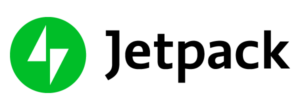No one expects it to happen to them, but WordPress websites are compromised regularly. When this occurs, website owners, especially those who haven’t taken careful security measures, lose important data and, in some cases, even access to their site.
If your website is hacked or infected with malware, Google will actively block it from appearing in its search results, even labeling it “unsafe” for visitors. According to Google statistics, nearly 30,000 websites are marked as unsafe every week, blocking traffic and damaging brand credibility.
Jetpack
Jetpack is the ultimate toolkit for WordPress. It gives you everything you need to secure, speed up, and grow your site in one place.
Jetpack can provide analytics on your website traffic, optimize its results, and let you customize its look and feel to monitor it for security threats.
But, because this article is about defense, let’s start with Jetpack’s security features:
- Backup your website: Jetpack can backup your website’s important data into the cloud. This way, even if your website is hacked, you won’t lose your data since it is stored separately. This functionality, however, is only available in one of the paid plans. And depending on which paid plan you are on, Jetpack will either backup your website’s data daily or in real-time.
- Brute-force protection: Many hackers try to force access into your website by constantly attempting to log in using different username/password combinations via automated bots. Jetpack blocks such brute-force attacks and the IP addresses from which the attacks are coming. This is one of Jetpack’s core features, meaning you get it regardless of whether you’re on a paid or free plan.
- Downtime Monitoring: In a rare case when your website is down (i.e. offline), Jetpack will immediately notify you via email that people can’t access your website. This is also a core feature available in all of Jetpack’s plans.
- Spam Filtering: Jetpack can scan and remove harmful spam messages and links, posted either by bots or by visitors, from your website. This feature is only available in the paid plans.
- Automatic Malware Scanning and Security Fixes: Without you having to lift a finger, Jetpack can automatically scan your website and notify you in case it finds malicious code and activity. Also, Jetpack will automatically resolve common threats by itself. But note that you can only get this functionality if you are on either the premium or professional plan.
Sucuri
While Jetpack has the plus of providing several capabilities, Sucuri takes the opposite path. Sucuri is focused on getting one job done—providing website security—and it does that really well.
It does everything you expect from a competent security service, such as scanning your website for malware, providing protection from hacking attempts and more. But the reason it stands out from other security plugins is due to how comprehensively it covers security needs.
The stand-out features it comes with are:
- WordPress Integrity Tool: This tool scans and reports any modifications made to your core WordPress files. These are the files you need for your website to function properly—and as such, they’re the ones most susceptible to attacks. In addition, Sucuri also comes with an Integrity Diff Utility, which shows exactly how your core files are modified, and what the original files look like.
- Audit Logs and Malware Scanner: Sucuri provides a complete report of all the activities happening on your website. It will alert you if it detects suspicious logins to your WordPress dashboard and if any harmful code is added.
- Firewall: Brute force attacks aren’t the only method hackers use. They also execute DDoS Attacks, SQL injections, and other similar methods to gain entry into websites. Sucuri protects websites from these attacks with its firewall and then backlists the IPs from which the attacks are coming.
WordFence
WordFence is the most downloaded WordPress security plugin and this is due to its robust data-powered security service.
Because it is already installed on a lot of WordPress websites, WordFence has the most up-to-date information on the new types of malware and hacking attempts being made to websites every day.
Armed with this information, it regularly updates its scanning tool and firewall with the latest security measures and rules to help protect websites against the latest hacks and malware.
Here are its top features:
- WordPress Firewall: The firewall is the biggest reason why you should get WordFence. Like we mentioned above, its security is constantly being updated, keeping up with the latest hacking methods and malware. And the cherry on top is that it’s an end-point firewall—meaning it operates directly from the server on which your website exists. This makes it even harder for hackers to bypass your website’s security.
- WordPress Security Scanner: Like other security plugins, WordFence comes with its own security scanner that checks all your website files for potential anomalies, harmful code, and suspicious changes. It also helps you repair any infected core WordPress files with the clean, default versions. Plus, it alerts you in case a search engine blacklists you and even shows you a list of potential vulnerabilities due to which your site may have been blocked.
- Login Security: This is one of WordFence’s underrated features. Login Security lets you add an additional layer of security to your WordPress login page via two great options: Two-Factor Authentication and Captcha. You can block administrators with compromised passwords from logging in as well.
- WordFence Central: If you have multiple websites, you can check the complete security status of each one of them on the WordFence Central Dashboard. You can get a complete report on all the notable security events that have occurred on your website: hacking attempts, blacklisted IPs, and malware removals. The dashboard will also notify you (via email, Slack or text) about any notable event happening on your website in real-time.
- Security Tools: WordFence offers many tools to customize the security of your website. For example, you can block attackers based on geography, IP address, and referrer. You can also scan the content posted on your website (either by you or other users) for viruses or spam.
iThemes Security
Using a security plugin can become confusing for a non-technical person. The advanced features can especially be hard to make sense of. This is an aspect that differentiates iThemes Security.
Similar to the other security plugins on our list, iThemes Security plugin provides an impressive number of security features—but unlike other tools, it makes it easy for people to understand what each feature does and how to implement it.
On its dashboard, you’ll find each iThemes Security feature represented in its own module with a clear description of what it does.
Since there are 30+ features, we’re only going to refer to top ones here:
- One-click Secure Site Security Check: The secure site button lets you activate all of iTheme’s important security features with just one click. By pressing this button, a total of 9 features will be activated, such as 2-Factor Authentication, Database Backup, Brute-force Protection, and more.
- Away Mode: By activating this module, your WordPress dashboard will become inaccessible and unchangeable during a time period of your choice.
- Strong Password Enforcement: By enabling this feature, every new administrator, editor, and user will have to create a strong password combination to sign up.
- Hide Login and Admin: Everyone knows the URL to the default WordPress login page, making it easy for hackers to attack it with brute-force attacks and more. To stop this, you can use this feature to hide the login and admin page by customizing its URL.
- Temporary Privilege Escalation: With this feature, you can grant any admin of your WordPress password with high-level access as set by you, for a specific period of time. Once the time expires, they’ll lose high-level access.
- Passwordless Logins: When activated, this module lets people log in without a password. It does so by sending the user a link via email to their associated email address. The user has to click that link in order to log in.
You’ll also get access to the standard security tools, such as a malware scanner, firewall, spam detector, and more.








